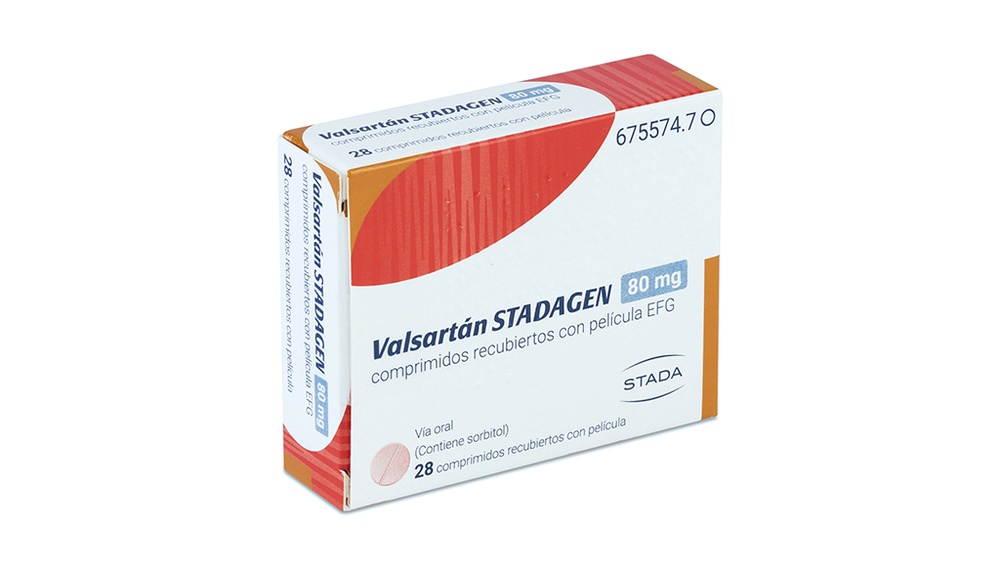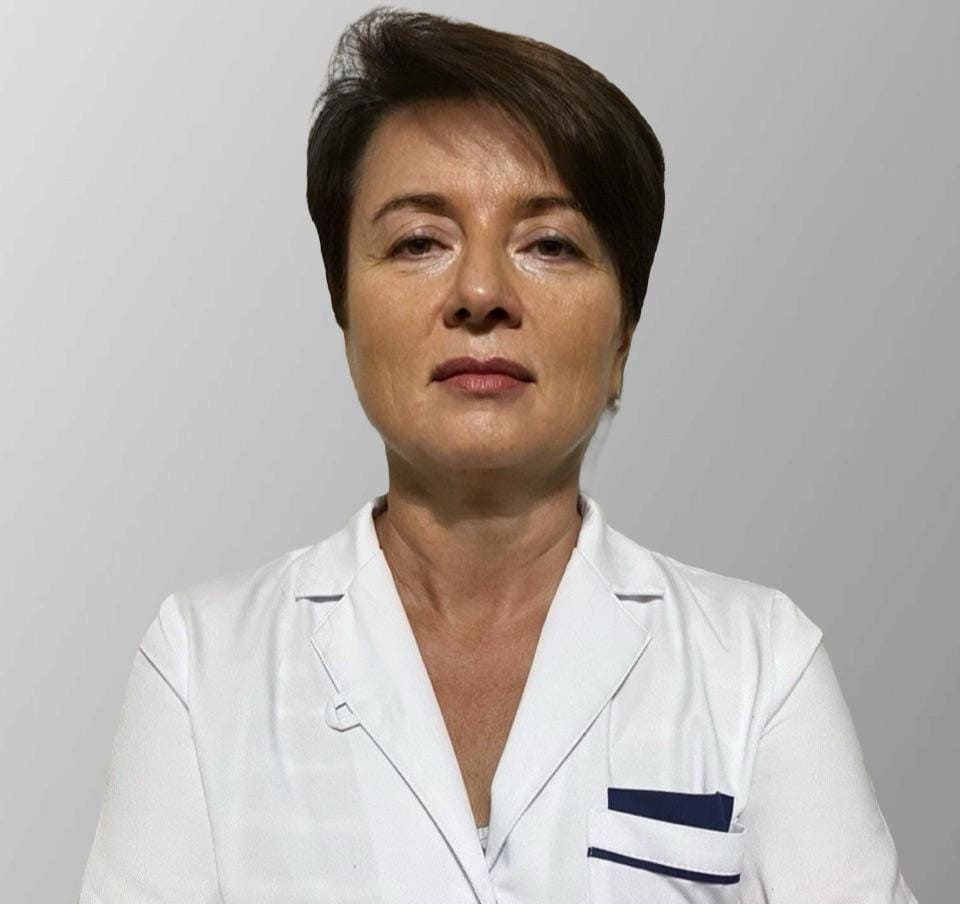

VALSARTAN STADAFARMA 80 mg COMPRIMIDOS REVESTIDOS POR PELÍCULA

Pergunte a um médico sobre a prescrição de VALSARTAN STADAFARMA 80 mg COMPRIMIDOS REVESTIDOS POR PELÍCULA

Como usar VALSARTAN STADAFARMA 80 mg COMPRIMIDOS REVESTIDOS POR PELÍCULA
Introdução
Prospecto: informação para o utilizador
Valsartán Stadafarma 80 mg comprimidos revestidos com película EFG
Leia todo o prospecto atentamente antes de começar a tomar este medicamento, porque contém informações importantes para si
- Conserva este prospecto, porque pode ter que voltar a lê-lo.
- Se tiver alguma dúvida, consulte o seu médico ou farmacêutico.
- Este medicamento foi-lhe prescrito apenas para si e não deve dá-lo a outras pessoas, mesmo que tenham os mesmos sintomas que o senhor, porque pode prejudicá-las.
- Se experimentar efeitos adversos, consulte o seu médico ou farmacêutico, mesmo que se trate de efeitos adversos que não aparecem neste prospecto. Ver secção 4.
Conteúdo do prospecto:
- O que é Valsartán Stadafarma e para que é utilizado
- O que precisa saber antes de começar a tomar Valsartán Stadafarma
- Como tomar Valsartán Stadafarma
- Efeitos adversos possíveis
- Conservação de Valsartán Stadafarma
- Conteúdo do envase e informação adicional.
1. O que é Valsartán Stadafarma e para que é utilizado
Valsartán pertence a uma classe de medicamentos conhecidos como antagonistas dos receptores de angiotensina II que ajudam a controlar a pressão arterial alta. A angiotensina II é uma substância do corpo que faz com que os vasos sanguíneos se estreitem, causando um aumento da pressão arterial. Valsartán actua bloqueando o efeito da angiotensina II. Como consequência, os vasos sanguíneos relaxam e a pressão arterial diminui.
Valsartán Stadafarma 80 mg comprimidos revestidos com película pode ser utilizado para três afeções diferentes:
- para tratar a pressão arterial alta de adultos e em crianças e adolescentes de entre 6 a 18 anos.A pressão arterial alta aumenta a carga de trabalho do coração e das artérias. Se não for tratada, pode danificar os vasos sanguíneos do cérebro, coração e rins e pode provocar um acidente vascular cerebral, insuficiência cardíaca ou insuficiência renal. A pressão arterial alta aumenta o risco de ataques cardíacos. A diminuição da pressão arterial para valores normais reduz o risco de desenvolver estes distúrbios,
- para tratar pacientes adultos após um ataque cardíaco recente(infarto de miocárdio). “Recente” significa aqui entre 12 horas e 10 dias,
- para tratar a insuficiência cardíaca sintomática em pacientes adultos.Valsartán é utilizado quando não se pode utilizar um grupo de medicamentos chamados inibidores da enzima conversora de angiotensina (ECA) (um medicamento para tratar a insuficiência cardíaca) ou pode ser utilizado adicionado aos ECA quando não é possível utilizar outros medicamentos para o tratamento da insuficiência cardíaca.
Entre os sintomas da insuficiência cardíaca figuram a dificuldade para respirar e a inchação de pés e pernas por retenção de líquidos. Deve-se ao facto de o músculo cardíaco não poder bombear o sangue com suficiente força para proporcionar todo o sangue necessário para o corpo.
2. O que precisa saber antes de começar a tomar Valsartán Stadafarma
Não tome Valsartán Stadafarma:
- se é alérgico(hipersensível) ao valsartán ou a qualquer um dos outros componentes de Valsartán Stadafarma, (incluídos na secção 6.)
- se sofre uma doença grave do fígado,
- se está grávida de mais de 3 meses. (é melhor evitar tomar valsartán durante os primeiros meses da gravidez - ver secção Gravidez).
- se tem diabetes ou insuficiência renal e está a ser tratado com um medicamento para reduzir a pressão arterial que contém alisquiren
Se alguma destas situações o afeta, informe o seu médico e não tome valsartán.
Advertências e precauções
Consulte o seu médico ou farmacêutico antes de começar a tomar valsartán:
- se sofre uma doença do fígado,
- se sofre uma doença grave dos rins ou se está a ser submetido a diálise,
- se sofre um estreitamento da artéria do rim,
- se foi submetido recentemente a um transplante de rim (recebeu um rim novo),
- se sofre uma doença cardíaca grave diferente da insuficiência cardíaca ou do ataque cardíaco,
- se já experimentou alguma vez inchação da língua e da face causada por uma reação alérgica chamada angioedema quando tomou outros medicamentos (incluídos os inibidores da ECA), informe o seu médico. Se tiver estes sintomas quando tomar valsartán, interrompa imediatamente o tratamento com valsartán e nunca mais o tome. Ver secção 4, “Efeitos adversos possíveis”.
- se está a utilizar medicamentos que aumentam a quantidade de potássio no sangue. Entre eles figuram os suplementos de potássio ou substitutos de sal que contêm potássio, os medicamentos poupadores de potássio e a heparina. Pode ser necessário controlar regularmente a quantidade de potássio no sangue,
- se sofre aldosteronismo, uma doença em que as glândulas suprarrenais produzem demasiada hormona aldosterona. Neste caso, não se recomenda tomar valsartán,
- se perdeu muito líquido (desidratação) devido a uma diarreia, vómitos ou doses elevadas de diuréticos (medicamentos para aumentar a eliminação de urina), informe o seu médico.
- se está a tomar algum dos seguintes medicamentos utilizados para tratar a hipertensão (pressão arterial alta):
- um inibidor da enzima conversora de angiotensina (ECA) (por exemplo enalapril, lisinopril, ramipril), em particular se sofre problemas renais relacionados com a diabetes.
- alisquiren
- se está a ser tratado com um ECA juntamente com outros medicamentos específicos para o tratamento da sua insuficiência cardíaca, conhecidos como antagonistas dos receptores de mineralocorticoides (ARM) (por exemplo, espironolactona, eplerenona) ou betabloqueantes (por exemplo, metoprolol)
Pode que o seu médico o controle a função renal, a pressão arterial e os níveis de eletrólitos (por exemplo, potássio) no sangue a intervalos regulares.
Consulte o seu médico se apresentar dor abdominal, náuseas, vómitos ou diarreia após tomar valsartán. O seu médico decidirá se continuar com o tratamento. Não deixe de tomar valsartán por sua conta.
Ver também a informação sob o título “Não tome Valsartán Stadafarma”.
Deve informar o seu médico se acredita que está (ou poderia estar) grávida. Valsartán não é recomendado no início da gravidez, e não deve ser tomado se está grávida de mais de 3 meses, porque pode causar danos graves ao seu bebé se o utilizar neste período (ver a secção gravidez).
Se alguma destas situações o afeta, informe o seu médico antes de tomar valsartán
Toma de Valsartán Stadafarma com outros medicamentos
Informe o seu médico ou farmacêutico se está a tomar, tomou recentemente ou poderia ter que tomar qualquer outro medicamento.
O efeito do tratamento com valsartán pode ser alterado se for tomado com certos medicamentos. Pode ser necessário mudar a dose, tomar outras precauções ou, em alguns casos, terminar o tratamento de algum dos medicamentos. Isto é aplicável tanto a medicamentos adquiridos com receita como sem receita, especialmente:
- outros medicamentos que diminuem a pressão arterial,especialmente diuréticos(medicamentos para aumentar a eliminação de urina), ECA (tais como enalapril, lisinopril, etc.,) ou alisquiren. (ver também a informação sob os títulos “Não tome Valsartán Stadafarma” e “Advertências e precauções”) .
- medicamentos que aumentam a quantidade de potássiono sangue. Entre eles figuram os suplementos de potássio ou substitutos de sal que contêm potássio, os medicamentos poupadores de potássio e a heparina,
- certos medicamentos para tratar a dorchamados anti-inflamatórios não esteroideos (AINEs),
- alguns antibióticos (do grupo da rifampicina), um medicamento utilizado para proteger contra o rejeição em um transplante (ciclosporina) ou um medicamento antirretroviral utilizado para tratar infecções VIH/SIDA (ritonavir). Estes medicamentos podem aumentar o efeito de valsartán
- lítio,um medicamento utilizado para tratar certos tipos de doenças psiquiátricas.
Além disso:
- se está a ser tratado após um ataque cardíaco,não se recomenda a combinação com inibidores da ECA (um medicamento para tratar um ataque cardíaco).
- se está a ser tratado para a insuficiência cardíaca,não se recomenda a tríplice combinação com inibidores da ECAe outros medicamentos específicos para o tratamento da sua insuficiência cardíaca, conhecidos como antagonistas dos receptores de mineralocorticoides (ARM)(por exemplo, espironolactona, eplerenona) ou betabloqueantes(por exemplo, metoprolol).
O seu médico poderá ter que ajustar-lhe a dose e/ou tomar outras precauções.
Toma de Valsartán Stadafarma com alimentos e bebidas
Pode tomar valsartán com independência dos alimentos
Gravidez e lactação
Consulte o seu médico ou farmacêutico antes de utilizar qualquer medicamento
- Deve informar o seu médico se está grávida(ou, se suspeita que poderia estar grávida).Por norma, o seu médico aconselhará que deixe de tomar valsartán antes de ficar grávida ou tão pronto quanto ficar grávida, e recomendará tomar outro medicamento anti-hipertensivo em seu lugar. Não se recomenda utilizar valsartán no início da gravidez e em nenhum caso deve ser administrado a partir do terceiro mês de gravidez porque pode causar danos graves ao seu bebé quando administrado a partir desse momento.
- Informe o seu médico se vai iniciar ou está em período de amamentaçãoposto que não se recomenda administrar valsartán a mulheres neste período. O seu médico pode decidir administrar-lhe um tratamento que seja mais adequado se quiser dar de mamar, especialmente a recém-nascidos ou prematuros.
Condução e uso de máquinas
Antes de conduzir um veículo, usar ferramentas ou manejar máquinas, ou realizar outras atividades que requeiram concentração, certifique-se de conhecer as suas reações aos efeitos de valsartán. Como muitos outros medicamentos utilizados para tratar a pressão arterial elevada, valsartán pode causar, em raros casos, tonturas e afetar a capacidade de concentração.
Valsartán Stadafarma contém sorbitol.
Este medicamento contém 9,25 mg de sorbitol em cada comprimido.
Valsartán Stadafarma contém sódio
Este medicamento contém menos de 23 mg de sódio (1 mmol); isto é, essencialmente “isento de sódio”.
Valsartán Stadafarma contém lactose
Se o seu médico lhe indicou que padece uma intolerância a certos açúcares, consulte com ele antes de tomar este medicamento.
3. Como tomar Valsartán Stadafarma
Para obter os melhores resultados e reduzir o risco de efeitos adversos, tome sempre valsartán exatamente como lhe indicar o seu médico. Consulte o seu médico ou farmacêutico se tiver dúvidas. As pessoas com pressão arterial alta não notam muitas vezes nenhum sinal da doença; muitas se sentem de forma normal. Isto torna muito importante comparecer às suas consultas com o médico, mesmo que se sinta bem.
Pacientes adultos com pressão arterial alta:a dose habitual é de 80 mg por dia. Em alguns casos, o seu médico pode prescrever doses mais elevadas (p. ex. 160 mg ou 320 mg). Também pode combinar valsartán com outro medicamento (p. ex. um diurético).
Crianças e adolescentes (6 a 18 anos de idade) com pressão arterial alta:
Em pacientes que pesam menos de 35 kg, a dose habitual é de 40 mg de valsartán uma vez por dia.
Em pacientes que pesam 35 kg ou mais, a dose recomendada de início é de 80 mg de valsartán uma vez por dia. Em alguns casos, o seu médico pode prescrever doses mais elevadas (a dose pode aumentar para 160 mg e até um máximo de 320 mg).
Em crianças que tenham dificuldade em engolir os comprimidos, recomenda-se a administração de valsartán solução oral.
Os pacientes adultosapós um ataque cardíaco recente:
Após um ataque cardíaco, geralmente começa às 12 horas, normalmente com uma dose baixa de 20 mg administrada duas vezes por dia. O seu médico aumentará esta dose gradualmente ao longo de várias semanas até um máximo de 160 mg duas vezes por dia. A dose final dependerá da sua tolerância particular. Valsartán pode ser administrado conjuntamente com outros tratamentos para o ataque cardíaco, e o seu médico decidirá qual tratamento é adequado para si.
Pacientes adultos cominsuficiência cardíaca:o tratamento começa geralmente com 40 mg duas vezes por dia. O seu médico aumentará a dose gradualmente ao longo de várias semanas até um máximo de 160 mg duas vezes por dia. A dose final dependerá da sua tolerância particular.
Valsartán pode ser administrado conjuntamente com outros tratamentos para a insuficiência cardíaca, e o seu médico decidirá qual tratamento é adequado para si.
Pode tomar valsartán com ou sem alimentos. Engula valsartán com um copo de água.
Tome valsartán aproximadamente à mesma hora todos os dias.
A ranhura serve apenas para partir o comprimido se lhe resultar difícil engoli-lo inteiro.
Se tomar mais Valsartán Stadafarmado que deve
Se notar um forte tontura ou desmaio, deite-se e contacte o seu médico imediatamente. Em caso de sobredose ou ingestão acidental, consulte imediatamente o seu médico ou farmacêutico ou ligue para o Serviço de Informação Toxicológica, telefone 91 562 04 20, indicando o medicamento e a quantidade ingerida.
Se esquecer de tomar Valsartán Stadafarma
Se esquecer de tomar uma dose, tome-a tão pronto quanto se lembrar. No entanto, se for quase a hora da dose seguinte, omita a dose esquecida.
Não tome uma dose dupla para compensar as doses esquecidas
Se interromper o tratamento com Valsartán Stadafarma
Se deixar o tratamento com valsartán, a sua doença pode piorar. Não deixe de tomar o medicamento a menos que o seu médico o indique.
Se tiver alguma outra dúvida sobre o uso deste produto, pergunte ao seu médico ou farmacêutico.
4. Efeitos adversos possíveis
Como todos os medicamentos, valsartán pode produzir efeitos adversos, embora nem todas as pessoas os sofram.
Alguns efeitos adversos podem ser graves e podem necessitar de atenção médica imediata:
Pode experimentar sintomas de angioedema (uma reação alérgica específica), tais como
- inchação na face, lábios, língua ou garganta,
- dificuldade para respirar ou engolir,
- urticária, picazón
Se experimentar algum destes sintomas, deixe de tomar valsartán e contacte o seumédico imediatamente (ver também secção 2 “Advertências e precauções”).
Outros efeitos adversos incluem:
Frequentes:podem afetar até 1 de cada 10 pessoas
- tontura
- pressão arterial baixa com ou sem sintomas como tontura e desmaio ao levantar-se,
- redução da função renal (sinais de deterioração renal).
Pouco frequentes:podem afetar até 1 de cada 100 pessoas
- angioedema (ver secção “Alguns efeitos adversos podem ser graves e podem necessitar de atenção médica imediata”)
- perda súbita do conhecimento (síncope)
- sensação de rotação, (vertigem)
- marca redução da função renal (sinais de insuficiência renal aguda),
- espasmos musculares, ritmo cardíaco anormal (sinais de hiperpotasemia),
- falta de ar, dificuldade para respirar estando deitado, inchação dos pés ou pernas (sinais de insuficiência cardíaca),
- dor de cabeça,
- tosse,
- dor abdominal,
- náuseas,
- diarreia,
- fadiga,
- fraqueza.
Muito raros:podem afetar até 1 de cada 10.000 pessoas
- angioedema intestinal: inchação no intestino que apresenta sintomas como dor abdominal, náuseas, vómitos e diarreia
Frequência não conhecida:(a frequência não pode ser estimada a partir dos dados disponíveis):
- bolhas na pele (sinal de dermatite bolhosa)
- podem ocorrer reações alérgicas com erupção cutânea, picazón e urticária sintomas: febre, inchação e dor nas articulações, dor muscular, inchação dos gânglios linfáticos e/ou sintomas semelhantes aos da gripe (sinais de doença do soro).
- manchas vermelhas purpúreas, febre, picazón (sinais de inflamação dos vasos sanguíneos, também chamada vasculite).
- hemorragia ou contusões mais frequentes do que o habitual (sinais de trombocitopenia).
- dor muscular (mialgia).
- febre, dor de garganta ou úlceras na boca por infecções (sintomas de baixo nível de glóbulos brancos, também chamado neutropenia).
- redução do nível de hemoglobina e redução do percentagem de glóbulos vermelhos no sangue (que, em casos graves, pode causar anemia).
- aumento do nível de potássio no sangue (que, em casos graves, pode provocar espasmos musculares e um ritmo cardíaco anormal).
- elevação dos valores da função hepática (que pode indicar lesão hepática), incluindo um aumento do nível de bilirrubina no sangue (que, em casos graves, pode provocar que a pele e os olhos fiquem amarelos).
- aumento do nível do nitrogênio ureico no sangue e aumento do nível de creatinina sérica (que podem indicar anomalias da função renal).
- baixo nível de sódio no sangue (que, em casos graves, pode provocar fadiga, confusão, contração muscular e/ou convulsões).
A frequência de alguns efeitos adversos pode variar em função do seu estado. Por exemplo, certos efeitos adversos como a tontura e a redução da função renal foram observados com menos frequência em pacientes tratados com hipertensão do que em pacientes tratados por insuficiência cardíaca ou após um ataque cardíaco recente.
Os efeitos adversos em crianças e adolescentes são semelhantes aos observados em adultos
Comunicação de efeitos adversos
Se experimentar qualquer tipo de efeito adverso, consulte o seu médico ou farmacêutico, mesmo que se trate de possíveis efeitos adversos que não aparecem neste prospecto. Também pode comunicá-los diretamente através do Sistema Espanhol de Farmacovigilância de Medicamentos de Uso Humano: https://www.notificaram.es. Mediante a comunicação de efeitos adversos, você pode contribuir para fornecer mais informações sobre a segurança deste medicamento
5. Conservação de Valsartán Stadafarma
Mantenha fora da vista e do alcance das crianças
Não conserve a uma temperatura superior a 30 °C. Conservar no envase original para protegê-lo da humidade.
Não utilize este medicamento após a data de caducidade que aparece no envase. A data de caducidade é o último dia do mês que se indica.
Não utilize este medicamento se observar que o envase está danificado ou mostra sinais de deterioração.
Os medicamentos não devem ser jogados nos deságues nem na lixeira. Deposite os envases e os medicamentos que não precisa no Ponto SIGRE da farmácia. Pergunte ao seu farmacêutico como se desfazer dos envases e dos medicamentos que já não precisa. Dessa forma, ajudará a proteger o meio ambiente.
6. Conteúdo do envase e informação adicional
Composição de Valsartán Stadafarma
- O princípio ativo é valsartán. Um comprimido de Valsartán Stadafarma 80 mg contém 80 mg de valsartán;
- Os outros componentes são: celulosa microcristalina (E 460), sílica coloidal anidra (E 551), sorbitol (E 420), carbonato de magnésio (E 504), amido pregelatinizado de milho, povidona K-25 (E 1201), fumarato de estearila e sódio, laurilsulfato sódio, crospovidona Tipo A (E 1202). Revestimento: lactosa monohidrato, hipromelosa (E 464), dióxido de titânio (E 171), macrogol.
- Valsartán Stadafarma 80 mg contém o corante óxido de ferro vermelho (E 172).
Aspecto do produto e conteúdo do envase
Valsartán Stadafarma 80 mg: são comprimidos cilíndricos, revestidos, de cor rosa e com ranhura em uma das faces.
Os comprimidos são apresentados em envases de 7, 14, 28, 56, 98 e 280 comprimidos revestidos com película.
Pode ser que apenas alguns tamanhos de envase sejam comercializados.
Titular da autorização de comercialização e responsável pela fabricação
Titular da autorização de comercialização
Laboratório STADA, S.L.
Frederic Mompou, 5
08960 Sant Just Desvern (Barcelona)
Espanha
Responsável pela fabricação
LABORATORIOS CINFA, S.A.
Olaz-Chipi, 10. Polig. Areta
31620 Huarte (Pamplona)
Espanha
Laboratorios LICONSA, S.A.
Avda. Miralcampo, Nº 7, Polígono Industrial Miralcampo
19200 Azuqueca de Henares (Guadalajara)
Espanha
ZENTIVA K.S.
- Kabelovny 130
10237 Praha 10,
República Checa
Podem solicitar mais informações sobre este medicamento dirigindo-se ao titular da autorização de comercialização
Data da última revisão deste prospecto:02/2025
A informação detalhada deste medicamento está disponível na página web da Agência Espanhola de Medicamentos e Produtos Sanitários (AEMPS) http://www.aemps.gob.es/

Quanto custa o VALSARTAN STADAFARMA 80 mg COMPRIMIDOS REVESTIDOS POR PELÍCULA em Espanha em 2025?
O preço médio do VALSARTAN STADAFARMA 80 mg COMPRIMIDOS REVESTIDOS POR PELÍCULA em dezembro de 2025 é de cerca de 8.15 EUR. Os valores podem variar consoante a região, a farmácia e a necessidade de receita. Confirme sempre com uma farmácia local ou fonte online para obter informações atualizadas.
- País de registo
- Preço médio em farmácia8.15 EUR
- Substância ativa
- Requer receita médicaSim
- Fabricante
- Esta informação é apenas para referência e não constitui aconselhamento médico. Consulte sempre um médico antes de tomar qualquer medicamento. A Oladoctor não se responsabiliza por decisões médicas baseadas neste conteúdo.
- Alternativas a VALSARTAN STADAFARMA 80 mg COMPRIMIDOS REVESTIDOS POR PELÍCULAForma farmacêutica: COMPRIMIDO, 160 mg valsartanSubstância ativa: valsartanFabricante: Novartis Farmaceutica S.A.Requer receita médicaForma farmacêutica: COMPRIMIDO, 320 mgSubstância ativa: valsartanFabricante: Novartis Farmaceutica S.A.Requer receita médicaForma farmacêutica: SOLUÇÃO/SUSPENSÃO ORAL, 3 mg/mlSubstância ativa: valsartanFabricante: Novartis Farmaceutica S.A.Requer receita médica
Alternativas a VALSARTAN STADAFARMA 80 mg COMPRIMIDOS REVESTIDOS POR PELÍCULA noutros países
As melhores alternativas com o mesmo princípio ativo e efeito terapêutico.
Alternativa a VALSARTAN STADAFARMA 80 mg COMPRIMIDOS REVESTIDOS POR PELÍCULA em Polónia
Alternativa a VALSARTAN STADAFARMA 80 mg COMPRIMIDOS REVESTIDOS POR PELÍCULA em Ukraine
Médicos online para VALSARTAN STADAFARMA 80 mg COMPRIMIDOS REVESTIDOS POR PELÍCULA
Avaliação de posologia, efeitos secundários, interações, contraindicações e renovação da receita de VALSARTAN STADAFARMA 80 mg COMPRIMIDOS REVESTIDOS POR PELÍCULA – sujeita a avaliação médica e regras locais.










